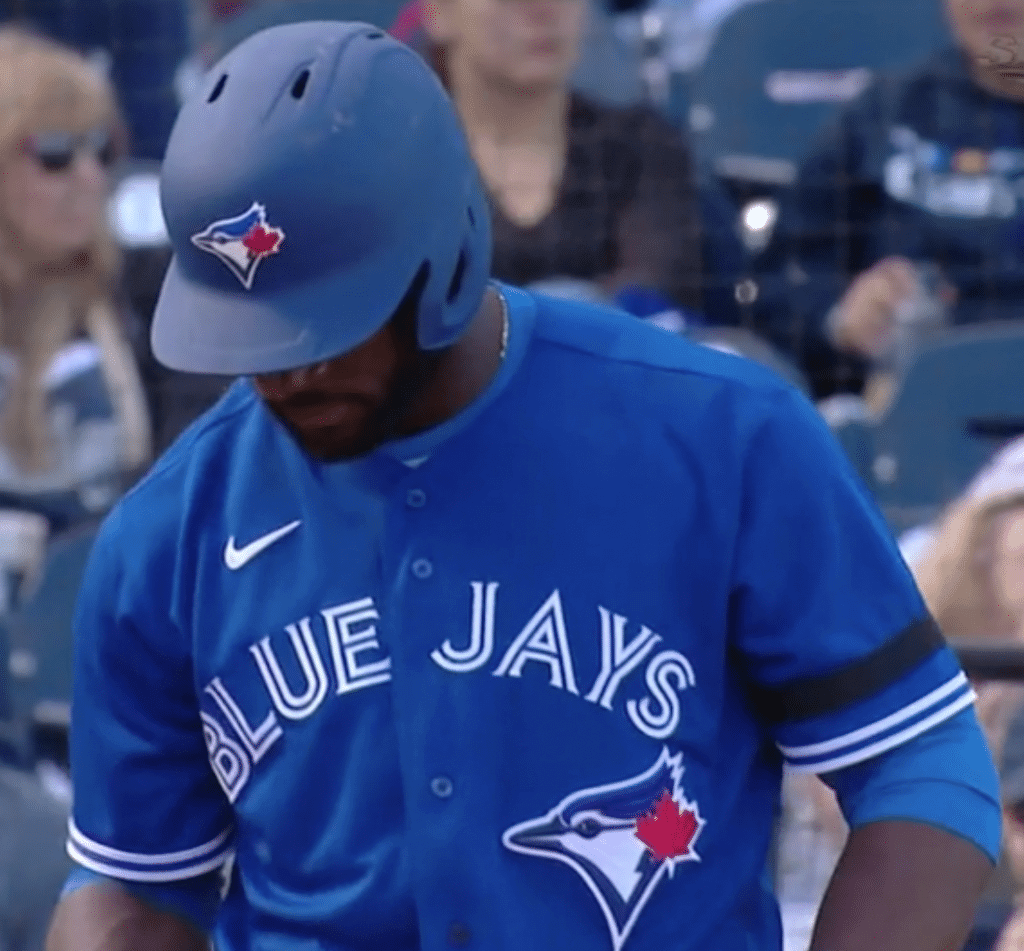
Click to enlarge
Paul here, filling in again for Phil, who’s off this weekend.
Grapefruit and Cactus League action got underway in earnest yesterday, and there were several uni-notable aspects of the Yanks/Jays game in Tampa. First, as you can see above, the Blue Jays have added a black armband. That’s for former player Tony Fernández, who died last Sunday.
Black armbands have become fairly uncommon in MLB, as custom-designed memorial patches have become the norm. It’s not yet clear, at least to me, if this armband is just a spring training thing, or if it’ll be worn all season long, or if it’s just a placeholder until the Jays have a patch ready to go. I’m trying to get clarification on that from the team — stay tuned.
In addition, as you can also see in that photo, the Jays have become the latest team to adopt a matte batting helmet with a 3D logo. But their base coaches are still wearing glossy helmets:
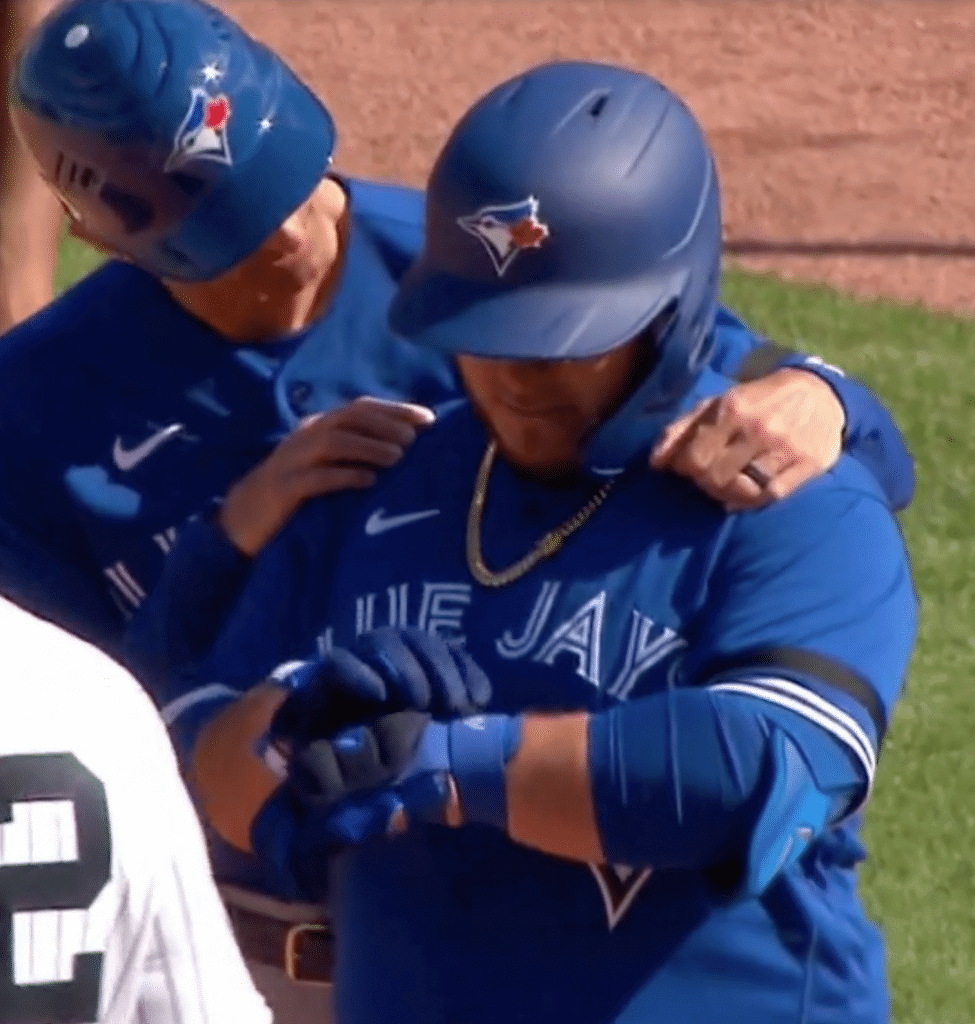
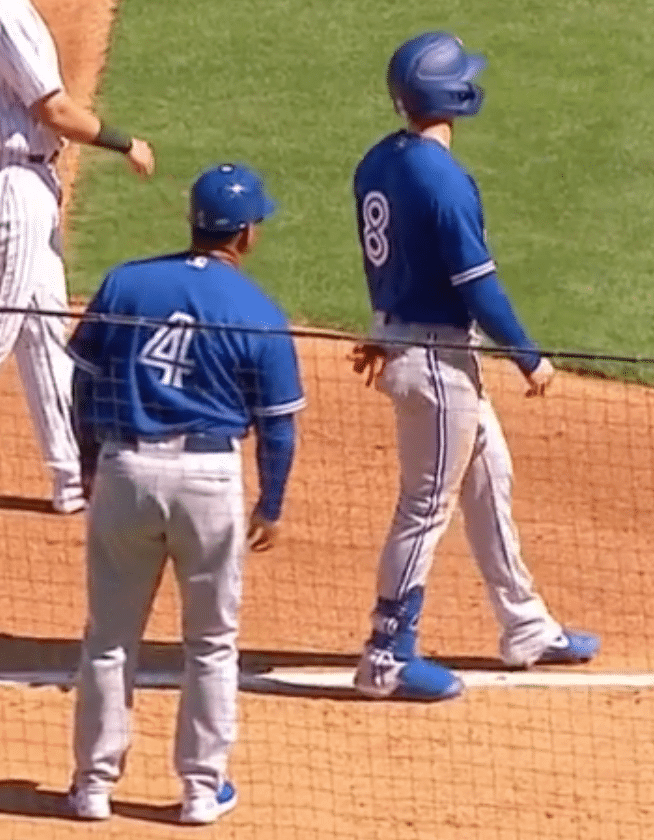
Seeing the two helmet finishes side by side, it seems pretty clear to me that the glossies look better. I like matte for certain teams, but not in this case.
Also of note from that game: As you may recall, the Yankees have been wearing a Steinbrenner Field 25th-season patch on their spring jerseys. But for yesterday’s game, their wore their standard pinstriped jerseys — which did not include the patch (even though the game was being played at Steinbrenner Field). Interesting.
And yes, the new maker’s marks on the jerseys looked like shit, but we all knew that would be the case.

Click to enlarge
Hoop-de-do: There were a couple of color-vs.-color college hoops games yesterday. Let’s start in the Sooner State, where Oklahoma and Oklahoma State went red vs. orange — ugh. I thought the entire sport of basketball had sworn off that color matchup after the Knicks and Hawks tried it in 2013, but apparently not.
Here are a few more shots from last night’s disaster:

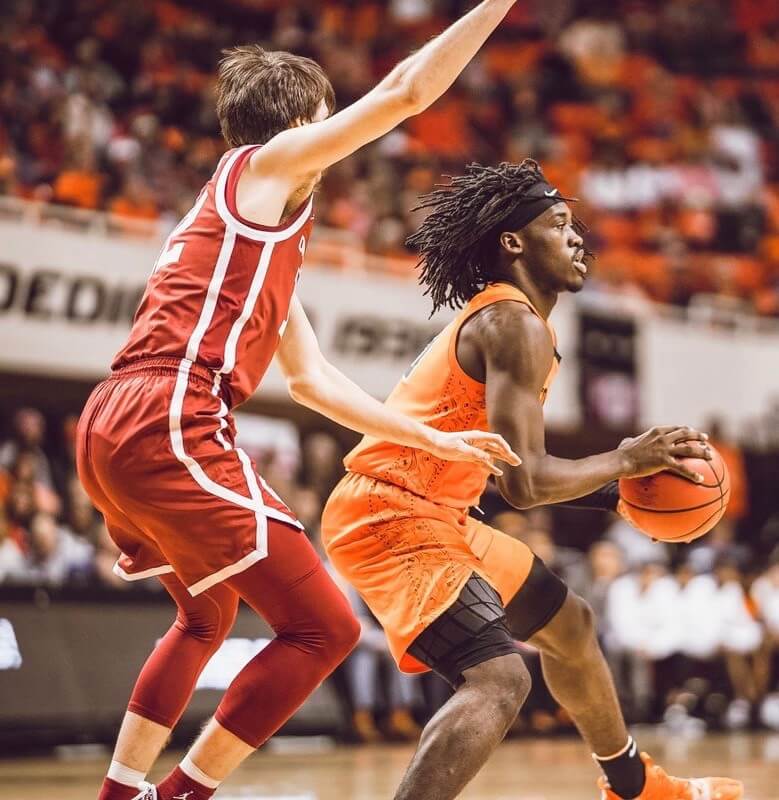
Meanwhile, Kansas State wore their lavender/purple throwbacks at home against Texas, creating a visual mishmash for the ages:


In order to fully appreciate how bad this one looked, you really need to see the players in action, so here are two video clips:
YESSIR @thrillbaker!! 😤😤#AllForTexas | #HookEm pic.twitter.com/cer1TyNmBV
— Texas Men's Basketball (@TexasMBB) February 22, 2020
Courtney Ramey IS ON FIRE.
He finishes the first half with 21 points for @TexasMBB. pic.twitter.com/SygL2q3LAz— CBS Sports CBB (@CBSSportsCBB) February 22, 2020
On the plus side: Very color-appropriate score bug design!
Video- In Goal For The Carolina Hurricanes Is: Here's something you don't see every day. After Petr Mrazek and James Reimer went down with injurues, emergency goalie David Ayres makes his @NHL debut! pic.twitter.com/5p5kFbqigG — Sportsnet (@Sportsnet)… https://t.co/qyjTKbhZns
— Kukla's Korner (@kuklaskorner) February 23, 2020
Not quite ready for prime time: During last night’s Hurricanes/Maple Leafs game in Toronto, ’Canes goalies Petr Mrazek and James Reimer both went down with injuries, so emergency netminder David Ayres, who’s the Zamboni driver for the AHL’s Toronto Marlies, was pressed into service — and made his NHL debut at the age of 42! As you can see in the video clip above, he took the ice in the second period wearing Marlies-themed blue pants, a blue/white mask, and blue/white pads (additional info here).
But by the time Ayres came out for the third period, someone had gotten him a pair of red pants (or maybe just a red shell to put over the blue pants):

Also: Ayres wore No. 90. According to Hockey-Reference.com, only 21 other players in NHL history have worn that number!
So how did he do? Ayres allowed goals on the first two shots he faced but then stopped the next eight shots, earned the win (reportedly becoming the first emergency goalie to do so in NHL history!), and was named the game’s first star. Here’s a great postgame interview with him:
"It was awesome. Time of my life out there."
After coming in as the emergency goalie for the @Canes, David Ayres spoke with @SNkylebukauskas about picking up his first @NHL win. pic.twitter.com/pNaxv6z880
— Sportsnet (@Sportsnet) February 23, 2020
(My thanks to the many people who were keeping track of this one.)
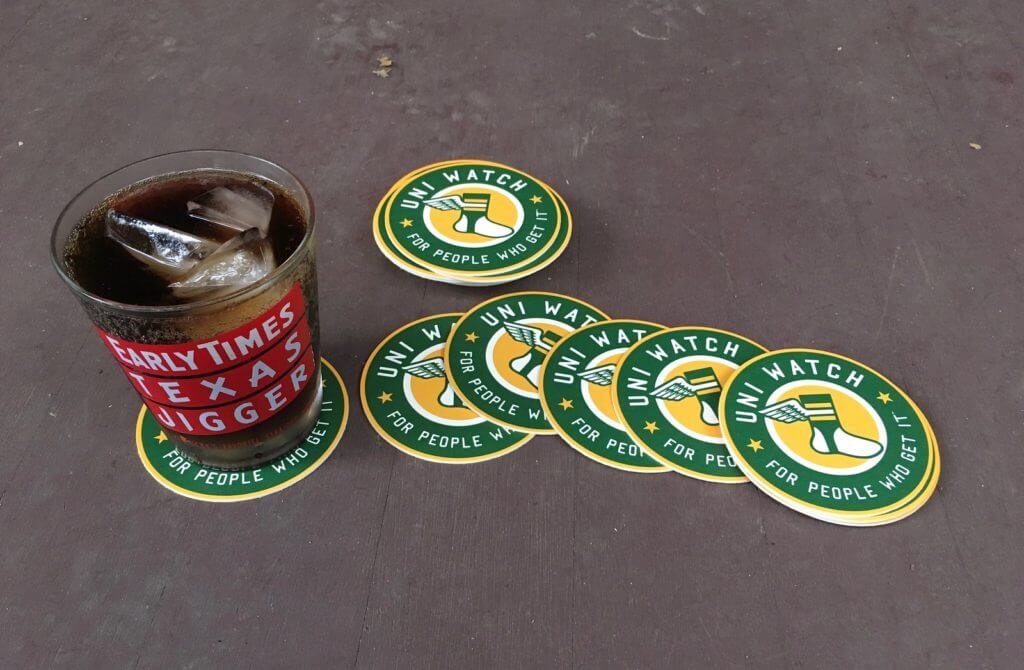
Click to enlarge
Going fast: As of now, I have six five four three two remaining sets of these great-looking Uni Watch coasters. I’m selling them in groups of three for $9 with free shipping. Get ’em while they last!
Sorry, no Ticker today, because I spent most of the day on hiking and eating in Staten Island and the rest of the Uni Watch team had the day off. We’ll get back to full content tomorrow — and I don’t mind saying that I have some really good content lined up for the coming week. See you then! — Paul
I’m curious how emergency goalies work in hockey. I thought teams needed to select an active lineup for every game, which usually results in at least 2 or 3 players as healthy scratches. So how does that leave room for an emergency goalie? In baseball, if you run out of pitchers, a position player has to fill in. In soccer, if both keepers on your 18 get hurt, one of your outfield players has to fill in. But it seems here that Toronto (and, I would presume, all teams) has at least one emergency guy available at all games. Obviously not under contract for the team.
It is an interesting set up. My understanding is that it is possible that the EBUG (emergency backup goaltender) in the arena that night may play for either team if needed.
He is an article listing recent EBUGs that have been used in the past decade.
link
That’s right – each team is required to have an EBUG on hand at every game, and they’re available to either team. They’re often local university/college goalies, except that there’s a USports rule (Canada’s NCAA equivalent) that you can’t book those players during the USports playoffs. The key is that they can’t have been under a pro contract at any level in the past.
Ayres had previously dressed as the regular backup for the Marlies at least once because of injuries.
Paul, two things for you:
1) Not just a blue/white mask, but a Marlies-themed mask – you can see the team’s alternate logo on the side in the photo above
2) The Canes released a 90 Ayres t-shirt in their online store right after the game. He’s not entitled to royalties, because he’s not an NHLPA member, but they’ve confirmed he’ll get a cut and that they’ll also be giving a cut to a kidney-related charity (as Ayres is a transplant survivor!).
Ayers: I wonder how they got a customized jersey prepared for him with such short notice. Did they already have it made up, or did they have to do some emergency sewing of his name and number at the last minute?
My understanding is that they had a No. 90/NNOB jersey ready to go, and they quickly heat-pressed the NOB lettering onto it but didn’t sew it down.
You can see a short snippet of it in this video:
link
I remember reading (after Scott Foster played for Chicago) that #90 is the standard number for each team to use for the EBUG.
@Fred, I — coincidentally, three days ago — watched some YouTube videos about emergency goalies and lots of them had regular-looking numbers like 31, 35, and 40.
But after Scott Foster’s ridiculously-good performance wearing #90 a few years ago, and now Ayres, I wonder if 90 will become the default EBUG number in the future.
Does San Diego State men’s hoops often wear black at home? They shouldn’t, and appropriately the team lost last night to UNLV, which was sporting its red uniforms.
1st emergency goalie in NHL history to get a win?
Is that true? Were there any emergency goalies in the era when teams only had one goalie that were credited with a win?
I should say “reportedly” (and will add that word now), because that’s what I heard, but I don’t know it for a fact.
I believe it’s true!
Scott Foster played as an emergency goalie for the Blackhawks and did make 7 saves on 7 shots but wasn’t rewarded with a win because he came in mid way through 3rd.
Jorge Alves suited up for the Hurricanes only for the 7 seconds left in the game.
How did they decide he was the winning goalie? The Canes were already winning when he came in.
Is there some rule, like with baseball pitchers, that the starting goalie has to remain in for a certain length of time to be the winner? Or does the scorer get to decide which goalie contributed the most?
From ESPN:
Ayres, a Zamboni driver and arena maintenance worker for the Maple Leafs’ AHL affiliate, the Toronto Marlies, has been the regular practice goaltender for the Marlies and has appeared at Maple Leafs practices and skills sessions this season. As the emergency goalie, he was available to either team, if needed.
Per NHL rules, Ayres was paid $500 for the game, and he was allowed to keep his game-worn jersey. He was greeted warmly by his teammates-for-a-night upon entering the locker room after the game.
The Yanks’ first season at GMS field was 1996, so this is the 25th season, not the 25th anniversary – unless the place opened for some other purpose in 1995? And wouldn’t you know it, the logo painted on the field said 25th season.
I suspect we’ll see the patch when they wear their spring training jerseys in a game.
I was also surprised to not see a memorial armband for Don Larsen. Perhaps they’ll wait until the season starts.
Paul, will you be telling us anything about your day spent in the forgotten borough?
Went hiking at Clay Pint Ponds State Park Preserve (a very satisfying name to say out loud). Then had pizza/beer at Lee’s Tavern. That’s most of it!
“anniversary” now changed to “season” — thanks.
Jeez, I can’t believe anyone would believe that orange and red are a good matchup. Being a USC alum I love the cardinal red versus UCLA light blue games. This works because of the contrast, and with UCLA’s light blue getting darker lately, it’s not as good as it once was.
The OU-OSU red-vs-orange game isn’t nearly as bad as the Hawks-Knicks or even the horrendous Auburn-Ole Miss game from 2011
link
Why isn’t it as bad?
I was thinking the same thing. The darker red (maroon?) contrasts with the orange much better than the other two examples (IMO). Those OSU side panels on the other hand…
My thoughts exactly. The Hawks’ & Knicks’ shades seem to be closer on the color spectrum than OSU’s & OU’s are.
I have to agree – matte helmets look good on some teams, but pretty bad on the Jays. Feels like matte for matte’s sake.
Everyone says matte looks good on some teams. Which teams? They don’t say.
I think they look shite on all teams. They don’t appear “major league”. It’s a low minors or college/high school look; teams that can’t always afford new, shiny equipment.
Agree with Nestor. Most of the time, matte helmets look to me like they’ve been sitting in storage, literally collecting dust, and nobody bothered to take some cleaner and a rag and wipe them off.
I agree – some teams just have an aesthetic that works with matter or gloss. Because the matte helmets look like old-time flocked batting helmets, to my eye teams with simpler looks and uniforms that have changed little since the 1950s are good fits for matte helmets. Dodgers, Yankees, Giants, for example. Most teams with more recent visual identities seem to me to work better with glossy helmets.
When the Celtics play the Lakers, Los Angeles should have the gold on their uniforms, and Boston the white.
Out of curiousity, when did color-on-color games stop being a common practice? It was a regular occurrence in college football, but at some point became a rarity. So much so that when USC-UCLA revived the trend about 10 years ago, each team was assessed a penalty at kickoff. In basketball, it’s not uncommon for a team with a light color as part of its scheme (e.g. Lakers) to host a color-on-color game, but it can be an eyesore (see Indiana at Illinois). Certain matchups (red-green or red/green-gray) should be avoided for color blind viewers, but color-on-color games could be more visually pleasing to watch (think Rams-49ers, Lakers-Celtics, or Canadiens-Leafs). Teams could go color-on-color with their standard dark jerseys, and only go white/light alternate if there was a conflict (e.g., Islanders-Rangers or Florida-Kentucky).
It had a lot to do with television. When they were just playing for the people in the stands, there just had to be enough contrast. Early television was black-and-white, so putting one team in white became necessary, and that remained the custom even when color televisions became ubiquitous. It’s only recently that color vs. color has emerged again.
An advantage of putting one team in white is that for road trips, equipment men only have to pack one set of uniforms. (That would be especially important in the days when teams flew commercial rather than charter.)